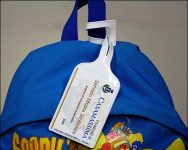
Italian school uses RFID system to automate lunch order and payment process
[ad_1]
Five public schools in Casamassima, Italy are using an RFID solution to identify arriving students and automate their lunch order and payment processes. Since the system was put into use in the fall of 2013, the system has reduced the number of school staff and has ensured that food is not wasted.
In this system, each student’s backpack is attached with a passive UHF RFID tag, and a reader entrance is installed at the entrance of the school. At the same time, a software is used to manage the read data and issue warnings. And payment management. The system is provided by the system integrator Cadan, and the RFID hardware used is provided by RFID Global.

The city of Casamassima has approximately 19,000 people, and the city’s five public elementary schools have 1,000 students (under 10). In the past, these students used food vouchers purchased by their parents at the city hall to pay in the cafeteria. One food voucher is required for each meal.
However, this process is quite time-consuming for schools, and school staff need to check every food stamp. If the student forgets to bring or loses the food stamp, the student can only continue to provide lunch. In addition, because the school does not know how many students eat at the school every day, they often buy excessive amounts of food, which also causes waste.
As a result, the city began to seek an automated system to replace paper food stamps and let schools know the need for food on a specific date. At the same time, these schools also hope that this system will allow parents to order online and confirm whether they need to purchase new electronic food coupons.
Carmelo Tommari, Technical Director of Cadan, said: “The biggest disadvantage of the manual food stamp system is that it cannot monitor and manage expenditures.” In other words, these schools cannot know the number of students ordering meals each day. Even if the student value is not paid, the school will still provide lunch, which will use up the city’s public funds and has been questioned by many people.
Therefore, the city of Casamassima contacted Cadan to find a solution. Cadan provided a software solution called Kubos to manage lunch payment data and installed an rfid reader to identify each student. At the beginning of 2013, the system was tested in Cadan’s test laboratory, and in September of the same year, the program came into effect.
The company’s marketing manager Paola Visentin said that the Feig Electronics ID ISC.LRU3000 long-distance reader provided by RFID Global was installed at the entrance of the school and connected to the Feig ISC.ANT.U270/270-EU antenna. An RFID badge containing an Alien Technology Higgs3 UHF RFID chip is attached to the student’s backpack. The unique ID number of each RFID tag is bound to the student’s name, payment status information and special dietary requirements information in the Kubos system.
When students arrive at the school, the reader at the gate will read the backpack tag ID and upload the data to the Kubos software via WiFi. The software can calculate the number of diners for each type of lunch and automatically deduct the lunch cost from the student’s account. In this way, the catering company can start preparing a certain number of lunches.

Visentin said that in the early stages of system deployment, RFID readers can read 99% of student tags. Next, the school adjusted the label positions of the other 1% of students and advised students not to put their hands on the labels when passing through the gate.
Tommasi said that since this system took effect, the region has saved the cost of printing paper food stamps. At the same time, the school has also reduced the manpower requirements for the confirmation and management of paper food stamps.
So far, based on labor demand, food waste and reduction in printing costs, the return on investment of the system is about 27%. Tommasi said: “The technology also brings other intangible benefits, such as: convenient for parents to pay, slow down the queue in the city hall and so on.”
Tommasi said that in the future, Casemassima will promote this program in all schools in the area. The system will also be integrated with time and attendance software to manage school class records.
(Exclusive manuscript of rfid world network, please indicate the source author for reprinting!)
[ad_2]




